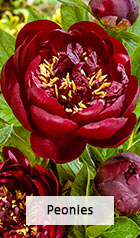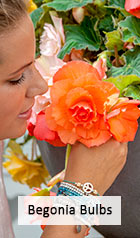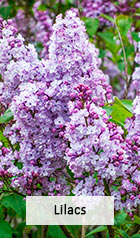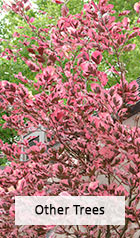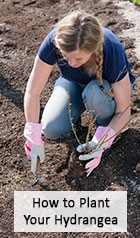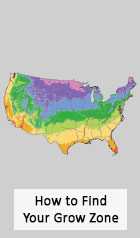- Fall Preview
- Perennials
Close X
Reliable color year after year.
- Bulbs
Close X
Fill your summer with blooms.
- Clematis & Vines
Close X
Provide ambiance and romance.
- Shrubs
Close X
Habitat, color & design possibilities.
- Trees
Close X
A gift for the next generation.
- Patio Orchard
- Fruits
- Tools & Décor
Close X
The right tools make gardening a pleasure.
- Spring Clearance
- Gardening Resources
Close X
Tips and tricks for easy, beautiful gardens.
Shrubs and Bushes
Shrubbery creates habitat, color & design possibilities.

Shrubs and bushes are the backbone of every well-balanced garden. Spring Hill offers a variety of shrubs in a broad range of shapes, sizes, flowers, and either deciduous or evergreen foliage to fill a landscape with form, greenery, color, and fragrance. Shop everything from deer-resistant to fast-growing shrubs, and everything in between. Spring Hill makes it easy to get just the right one because you can have plants delivered directly to your door. Providing a transition between trees and ground covers, shrubs and bushes soften boundary edges and buildings. Tall shrubs create a backdrop for flower borders or a screen to block noise, while denser varieties are useful for hiding eyesores like HVAC units or trash cans. Ornamental shrubs, like lilacs, accent architecture, patios, and garden elements such as gazebos. Many shrubs and bushes also provide additional garden interest and a good food source for wildlife thanks to colorful berries and a range of changing foliage colors. In addition to our fast-growing and deer-resistant shrubs, we also offer especially fragrant and drought-tolerant options. When choosing ones for your garden, consider characteristics such as size at maturity, leaf form and color, flower or berries, bloom time, and seasonal color. Our colors range from red to green and we also have mixed-colored picks. While most shrubs are low maintenance, be sure to look at hardiness zones, pruning needs, and sun, soil, and water requirements.
What Are Shrubs?
Landscape-worthy shrubbery includes everything from hedges to lilacs, azaleas, and many other plants. Choosing the right kind of shrub, small tree, or bush depends upon your climate, landscape, planting area size, and needs. What type of bush or shrub makes sense for your yard?
Flowering Shrubs
Flowering shrubs, such as butterfly bushes, azaleas, viburnum, and other favorites provide shade, privacy, structure and, of course, beautiful blooms. Flowering shrubs can work well in hedgerows, or choose a favorite to place as a specimen plant alongside smaller perennials, bulbs, and annuals.
When choosing flowering shrubs, consider bloom times. With some advance planning, you can ensure that your shrubs are blooming even when other perennials are not, keeping the color show alive in your garden all season long. Azaleas, forsythia, viburnum and lilacs bloom in spring, while hydrangeas, viburnum and butterfly bushes bloom in late summer. Don't discount the foliage of your blooming shrubs and bushes, either. Many varieties of flowering shrubs bear fruit, or offer vibrant foliage alongside their blooms for three-season performance.
Evergreen Shrubs
Evergreens are among the most popular choices for shrubs and hedges, and with good reason. Coniferous plants, such as arborvitae, juniper, and boxwood, stay green all year and offer unfailing service as in privacy fences, windbreaks or snow protection. Some of the best natural fencing available, evergreen shrubbery doesn't need to be monotone. Boxwood and cypress plants have been used for centuries in topiaries, and many conifer varieties feature stunning displays of varied needles.
Deciduous Shrubs
While deciduous shrubs don't hold their color year-round, many deciduous hedge plants and trees offer a gorgeous display of glossy leaves through the summer and colorful autumnal foliage in the fall. Spirea, chokecherry, barberry, and dogwood shrubs are all wonderfully hardy three-season plants. And, bare can be quite beautiful. Consider the appearance of the bark and stems of these shrubs as a way to add interest to the winter landscape.
Shrubs for Hedging
Hedges basically consist of multiple shrubs planted in a grouping, to create a border or boundary. Privacy hedges include taller shrubs, and can serve as a windbreak or a sound barrier. Tall arborvitae and cedars are popular for those purposes, and provide a beautiful backdrop for your garden or lawn.
Shorter hedges can be useful in creating borders, and carving your landscape into smaller areas. Try boxwoods, shorter flowering shrubs like dogwoods, and even mockorange or juniper fruiting shrubs to create a special area for seating or relaxing.
Fruit-Bearing Plants as Shrubs
Blueberries, serviceberries, or other fruiting shrubs aren't only productive--they're beautiful, too. Allow berry bushes to serve double duty by utilizing them as ornamentals. They produce delicious fruits and attractive flowers, and many berry bushes offer blazingly beautiful fall foliage, too. Blueberries in particular work well in container plantings, hedgerows, or as specimen plants.
No matter what type of shrubbery you choose, small woody plants can add shape and structure to your landscape. And, they're easy to plant and easy to care for!
How To Plant Shrubs
Looking for a guide to planting shrubs? Planting nursery stock requires a bit of forethought, but the process itself is relatively simple. Choose the right kind of shrubs for your climate and zone, considering the full grown height of your shrubs, as well as the mature spread of the plantings. Once you've selected the right plants for your needs, the business of planting begins.
- If you're planting multiple shrubs, sketch out your planned arrangement, to ensure that you have space for each. Consider whether you want a straight, symmetrical hedgerow, or a more natural, informal planting.
- Use a shovel or spade to remove the grass at your planting site, and remove any leaf litter or mulch. Prepare a planting area about twice as wide as the pot in which your shrub arrived.
- Dig a hole as deep as the container in which your plant arrived, and about twice as wide in circumference. Use a measuring stick or tape to ensure that the hole is dug to the correct depth.
- If the plant is in a plastic container, remove it from the pot and gently break up bound roots. If it is a bareroot plant, gently unwrap the roots and trim away any damaged pieces.
- Set the shrub, and begin backfilling the hole. Water in the plant as you fill it, to remove any pockets of air. Once it is set, water again thoroughly.
New shrubs seldom need heavy fertilization, but they do need to be watered frequently and deeply for the first year. If you live in a cold climate, cover the base of your shrub with a thin layer of mulch, but don't pile mulch up the trunk of the shrub.
How To Arrange Shrubs
Shrubs are trickier to re-plant than perennials, so make sure to place them in an arrangement and location that you'll love for years to come. When planning your shrubbery arrangement, consider some of these options:
- Plant a formal hedge with evenly spaced, tidily trimmed evergreen hedges. Use plants of the same variety for a uniform, simple look.
- For a more informal aesthetic, mix floral shrubs into your evergreen hedge, or use a mixture of species for varied textures and shapes. Bushier, more natural silhouettes work well in informal or cottage plantings, too.
- Plant a single shrub or bush as a species planting, or plant them in groups of three on the corners of buildings or in "island" plantings.
- A border of dwarf shrubs can create something of a living room in your outdoor spaces, or divide a special gardening area.
- If you're using large shrubs and wish to create a borderline, stagger them to allow them to fill in nicely. Staggered plantings are especially effective in a privacy hedge.
Shrubs are some of the most notable and permanent parts of your landscape, so arrange them with care. And, don't forget to include other plantings alongside your shrubbery. Some climbing perennials, like climbing clematis, pair nicely with shrubbery as they like to climb woody branches. Or, plant shade-loving perennials in the shadows of large shrubs.
When To Trim Shrubs
Most shrubs should be trimmed in spring or early summer, just as new growth begins to appear. Trimming in fall can put too much stress on shrubs as they head into the winter months, so only remove dead or damaged branches during fall clean-up. Flowering shrubs should be deadheaded after their flowers fade to encourage reblooming and prevent disease. Summer-flowering shrubs are the exception to this rule, and can be trimmed in the fall just after they bloom.
How To Trim Shrubs
Trimming shrubs is a simple weekend job, especially with the right tools. Use a gas-powered or electric trimmer for larger branches, and a hand-held pair of clippers for smaller ones. Most trees and shrubs do not require "wound care" and will heal on their own without the use of commercial tree bandaging. Loppers or trimmers should be kept clean and sharp to promote clean cuts and quick healing.
Start at the base of the shrub and work your way upward, keeping an eye on shaping. If you're working with a mature, overgrown shrub, select and remove large branches first before moving to smaller shoots and suckers. If the shrub needs to be thinned, use evenly-spaced cuts to remove deep-seated branches and allow air flow to the center of the shrub. Be sure to remove any dead or diseased branches, as well as shoots that don't conform to the desired shape of the tree.
How To Care For Shrubs
With just a little trimming and basic upkeep, you can enjoy your shrubs for decades. To take care of shrubs long-term, you'll need to adjust their care based on age. Newly-planted shrubs require lots of water, so set a soaker hose to water the plants for ten minutes per day during the spring, summer and fall. Young shrubs do not need to be fertilized, but may appreciate a light application of compost in the spring and fall. As the plants mature, relax your watering schedule and use a basic fertilizer for shrubs twice per year.



